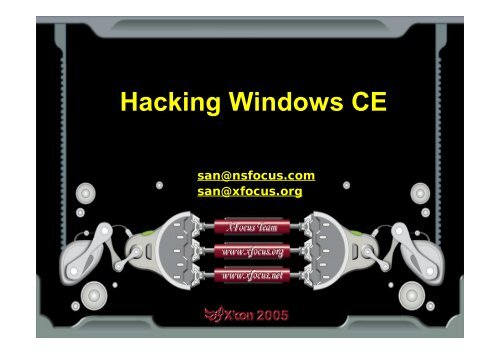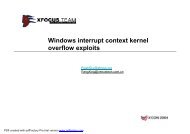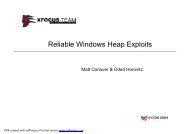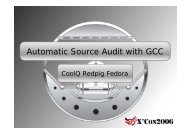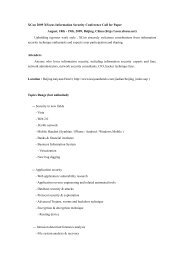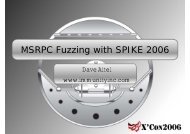Create successful ePaper yourself
Turn your PDF publications into a flip-book with our unique Google optimized e-Paper software.
<strong>Hacking</strong> <strong>Windows</strong> <strong>CE</strong>san@nsfocus.comsan@xfocus.org
Structure Overview<strong>Windows</strong> <strong>CE</strong> Overview<strong>Windows</strong> <strong>CE</strong> Memory Management<strong>Windows</strong> <strong>CE</strong> Processes and Threads<strong>Windows</strong> <strong>CE</strong> API Address Search TechnologyThe Shellcode for <strong>Windows</strong> <strong>CE</strong>System Call<strong>Windows</strong> <strong>CE</strong> Buffer Overflow DemonstrationAbout Decoding ShellcodeConclusionReference
<strong>Windows</strong> <strong>CE</strong> Overview(2)ARM ArchitectureRISCARMv1 -v6
Memory Management(1)<strong>Windows</strong> <strong>CE</strong> uses ROM (read only memory),RAM (random access memory)The ROM in a <strong>Windows</strong> <strong>CE</strong> system is like a smallread-only hard diskThe RAM in a <strong>Windows</strong> <strong>CE</strong> system is divided intotwo areas: program memory and object store<strong>Windows</strong> <strong>CE</strong> is a 32-bit operating system,so it supports 4GB virtual address spaceUpper 2GB is kernel space, used by thesystem for its own dataPart 2/8
Memory Management(2)
Memory Management(3)Lower 2GB is user space0x42000000-0x7FFFFFFF memory isused for large memory allocations, suchas memory-mapped files0x0-0x41FFFFFF memory is divided into33 slots, each of which is 32MB
Memory Management(4)Slot 0 layout
Processes and Threads(1)<strong>Windows</strong> <strong>CE</strong> limits 32 processes being run at anyone timeEvery process at least has a primary threadassociated with it upon starting (even if it neverexplicitly created one)A process can created any number of additionalthreads (only limited by available memory)Each thread belongs to a particular process (andshares the same memory space)SetProcPermissions API will give the current threadaccess to any processEach thread has an ID, a private stack and a set ofregistersPart 3/8
Processes and Threads(2)When a process is loadedAssigned to next available slotDLLs loaded into the slotFollowed by the stack and default process heapAfter this, then executedWhen a process’ thread is scheduledCopied from its slot into slot 0This is mapped back to the original slotallocated to the process if the processbecomes inactive
Processes and Threads(3)Processes allocate stack for each thread,the default size is 64KB, depending on thelink parameter when the program iscompiledTop 2KB used to guard against stack overflowRemained available for useVariables declared inside functions areallocated in the stackThread’s stack memory is reclaimed when itterminates
API Address Search(1)Locate the loaded address of the coredll.dllstruct KDataStruct kdata; // 0xFFFFC800: PUserKData0x324 KINX_MODULES ptr to module listLPWSTR lpszModName; /* 0x08 Module name */PMODULE*/pMod; /* 0x04 Next module in chainunsigned long e32_vbase;of module *//* 0x7c Virtual base addressstruct info e32_unit[LITE_EXTRA]; /* 0x8c Array of extra infounits */0x8c EXP Export table positionPocketPC ROMs were builded with Enable Full Kernel ModeoptionWe got the loaded address of the coredll.dll and its exporttable position.Part 4/8
API Address Search(2)Find API address via IMAGE_EXPORT_DIRECTORYstructure like Win32.typedef struct _IMAGE_EXPORT_DIRECTORY{......DWORD AddressOfFunctions; // +0x1c RVAfrom base of imageDWORD AddressOfNames; // +0x20 RVAfrom base of imageDWORD AddressOfNameOrdinals; // +0x24 RVAfrom base of image// +0x28} IMAGE_EXPORT_DIRECTORY,*PIMAGE_EXPORT_DIRECTORY;
API Address Search(3)Export Directory0x1c“KernelIoControl”Names Ordinals Functionsaddress
Shellcode(1)test.asm -the final shellcodeget_export_sectionfind_funcfunction implement of the shellcodeIt will soft reset the PDA and open itsbluetooth for some IPAQs(Forexample, HP1940)Part 5/8
Shellcode(2)Something to attention while writingshellcodeLDR pseudo-instruction"ldr r4, =0xffffc800" => "ldr r4, [pc, #0x108]""ldr r5, =0x324" => "mov r5, #0xC9, 30"r0-r3 used as 1st-4th parameters of API,the other stored in the stack
Shellcode(3)EVC has several bugs that makesdebug difficultEVC will change the stack contents whenthe stack reclaimed in the end of functionThe instruction of breakpoint maybechange to 0xE6000010 in EVCsometimesEVC allows code modify .text segmentwithout error while using breakpoint.(sometimes it's useful)
System Call<strong>Windows</strong> <strong>CE</strong> APIs implement bysystem callThere is a formula to calculate thesystem call address0xf0010000-(256*apiset+apinr)*4The shellcode is more simple and itcan used by user modePart 6/8
Buffer Overflow Demo(1)hello.cpp -the vulnerable programReading data from the "binfile" of the root directory tostack variable "buf" by fread()Then the stack variable "buf" will be overflowedARM assembly language uses bl instruction to callfunction"str lr, [sp, #-4]! " -the first instruction of thehello() function"ldmia sp!, {pc} " -the last instruction of the hello()functionOverwriting lr register that is stored in the stack willobtain control when the function returnedPart 7/8
Buffer Overflow Demo(2)The variable's memory addressallocated by program iscorresponding to the loaded Slot,both stack and heapThe process maybe loaded into thedifference Slot at each start time, sothe base address always altersSlot 0 is mapped from the currentprocess' Slot, so its stack address isstable
Buffer Overflow Demo(3)
Buffer Overflow Demo(4)A failed exploit–The PDA is frozen when the hello programis executed–Why? •The stack of <strong>Windows</strong> <strong>CE</strong> is small•Buffer overflow destroyed the 2KBguard on the top ofstack boundary
Buffer Overflow Demo(5)A successful exploit -exp.cThe PDA restarts when thehello program is executedThe program flows to ourshellcode
About Decoding Shellcode(1)Why need to decode shellcode?The other programs maybe filter thespecial characters before string bufferoverflow in some situationsIt is difficult and inconvenient to write ashellcode without special characters byAPI address search method in <strong>Windows</strong><strong>CE</strong>Part 8/8
About Decoding Shellcode(2)The newer ARM processor hasHarvard ArchitectureARM9 core has 5 pipelines and ARM10core has 6 pipelinesIt separates instruction cache and datacacheSelf-modifying code is not easy toimplement
About Decoding Shellcode(3)A successful exampleonly use store(without load) to modifyself-codeyou'll get what you want after paddingenough nop instructionsARM10 core processor need more padinstructionsSeth Fogie's shellcode use this method
About Decoding Shellcode(4)A puzzled exampleload a encoded byte and store it afterdecodedpad instructions have no effectSWI does nothing except 'movs pc,lr'under <strong>Windows</strong> <strong>CE</strong>On PocketPC, applications run in kernelmode. So we can use mcr instruction tocontrol coprocessor to manage cachesystem, but it hasn't been successful yet
ConclusionThe codes talked above are the real-lifebuffer overflow example in <strong>Windows</strong> <strong>CE</strong>Because of instruction cache, the decodingshellcode is not good enoughInternet and handset devices are growingquickly, so threats to the PDAs and mobilesbecome more and more seriousThe patch of <strong>Windows</strong> <strong>CE</strong> is more difficultand dangerous
Reference[1] ARM Architecture Reference Manualhttp://www.arm.com[2] <strong>Windows</strong> <strong>CE</strong> 4.2 Source Codehttp://msdn.microsoft.com/embedded/windowsce/default.aspx[3] Details Emerge on the First <strong>Windows</strong> Mobile Virushttp://www.informit.com/articles/article.asp?p=337071[4] Pocket PC Abuse - Seth Fogiehttp://www.blackhat.com/presentations/bh-usa-04/bh-us-04-fogie/bh-us-04-fogie-up.pdf[5] misc notes on the xda and windows cehttp://www.xs4all.nl/~itsme/projects/xda/[6] Introduction to <strong>Windows</strong> <strong>CE</strong>http://www.cs-ipv6.lancs.ac.uk/acsp/Win<strong>CE</strong>/Slides/[7] Nasiry 's wayhttp://www.cnblogs.com/nasiry/[8] Programming <strong>Windows</strong> <strong>CE</strong> Second Edition - Doug Boling[9] Win32 Assembly Componentshttp://LSD-PLaNET
Thank You!san@nsfocus.comsan@xfocus.org


